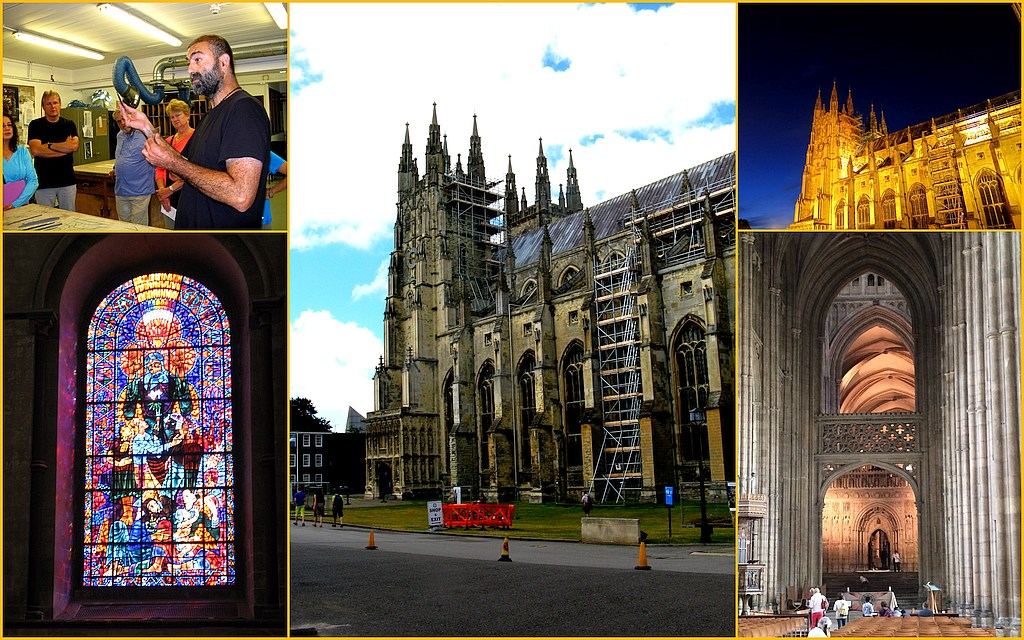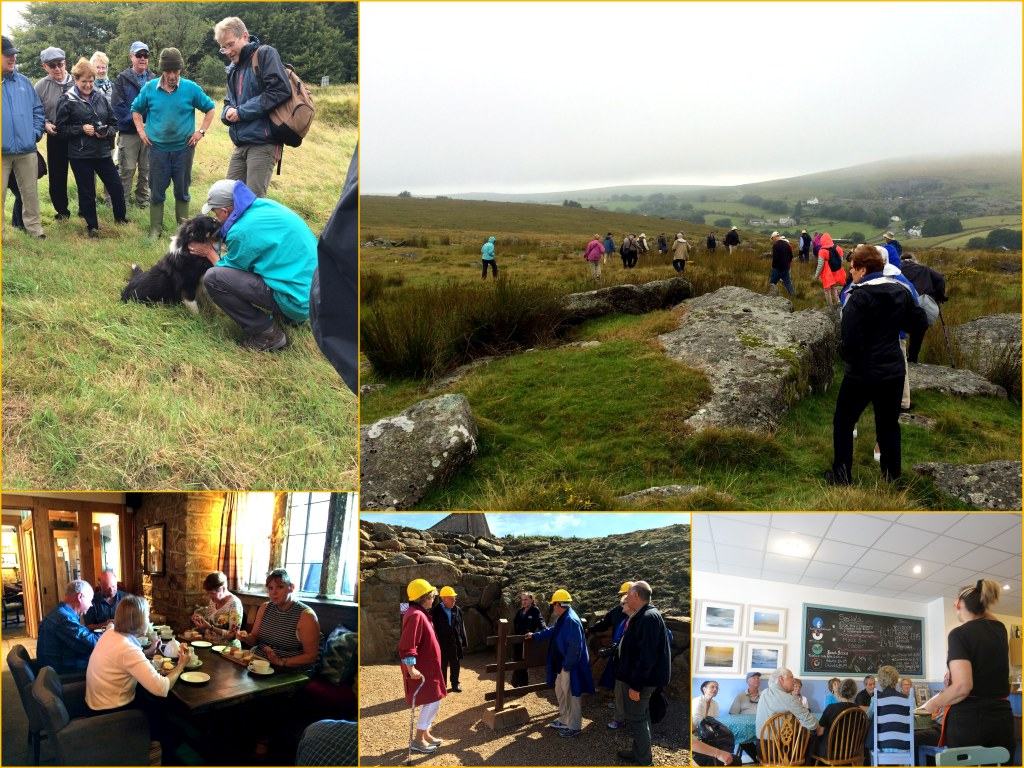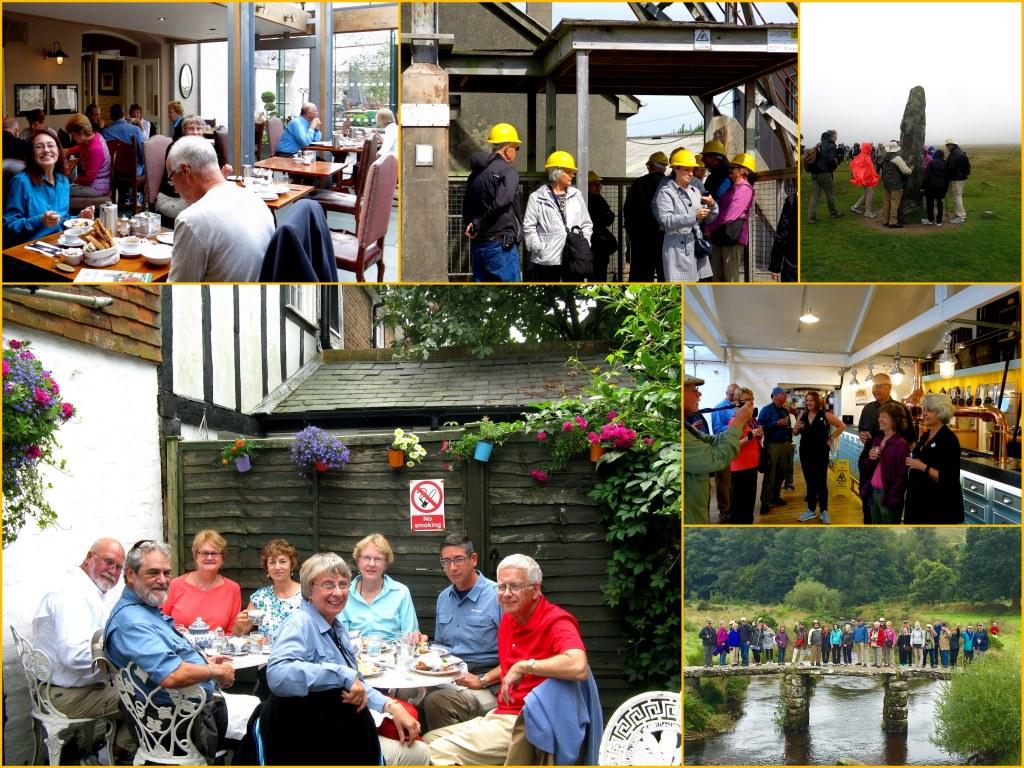Canterbury Cathedral, Canterbury, County Kent

| Villages of South England, August, 2016 |
|---|
| | | Return to Home Page | | |
|---|
Introduction
Though Joyce had been to England before I was looking forward to my first visit. Having often enjoyed group travel we searched for an extended tour and found it in Rick Steves Villages of South England in 13 Days. Not a fan of heavily populated cities the smaller towns along the Southern coast of England filled my bill.
| | | Return to Home Page | | |
|---|
We began our odyssey in Canterbury. Feeling much the VIPs, ID badges and all, we were accommodated within the cathedral walls in the Canterbury Cathedral Lodge. In the photo above, center, surrounded by scaffolding the cathedral is in a constant state of repair as the effects of time, weather and acid rain take their toll. Above, top right, bathed in a golden glow the scaffolding melts away leaving a vision of how the original builders saw their creation. Lower right, is an interior looking toward the high alter from the West door. For a detailed top down schematic view of the cathedral floor plan and architectural and historical details click here. Above, top left, a conservator at the stained glass studio demonstrated the varied skills required and procedures used to maintain the cathedral windows. Above, lower left, a recent addition, the Peace Window (1956) by Ervin Bossanyi in the southeast transept. The window depicts Christ welcoming children of all nations.
| | | Return to Home Page | | |
|---|
Given its' strategic location across the English Channel from France, Dover Castle has been known as the Key To England since the 12th century. In the photo above, upper left, just below the entrance, our guide, Mark, gave us an introduction to the largest castle in England. I'm the one with the developing tonsure on his head. Above, lower left, is an exterior view of the castle looking toward the entry gates. Above, lower right, is a view from castle's highest point of the city, its docklands and the harbor. From this harbor Operation Dynamo , also known as The Miracle of Dunkirk, was coordinated. Above, upper right, is the entrance to the Dover WWII tunnels. Above, top center, is a portion of the White Cliffs of Dover, a welcome sight to WWII bomber crews struggling home from raids over Germany.
| | | Return to Home Page | | |
|---|
The Pasty must be considered Cornish "soul food". We stopped at the Portreath bakery only to find it closed courtesy of an industrial accident. As an alternative we stopped at the local restaurant affiliated with the bakery. We were met by Marion who gave a hands on lesson in Pasty making. Grab a handful of beef, a handful of chopped veggies and a large pat of butter and place them in the center of a round of dough. Then the fun, depending on your personal results, fold over the dough rounding and crimping the edges. Sounds simple, yeah, one would think so, perhaps after the first 2000. Pull, twist, tuck under. Some were more successful than others with moi deferring to a professional baker. In the photo above, bottom right, Marion shows how it's done, Upper right, results of our labors ready for the oven. Lower left, Joyce displays her finished Pasty.
The Pasty was the traditional food of Cornish Tin miners. Holding the Pastyby the crimped end a miner could eat his meal without poisoning himself with the Tin residue on his hands.
Some heretics claim the Pastycame from Devon, Wales or even (gasp!) in London. Residents of Cornwall strongly disagree. The Pastyhas followed the trail of the The Cornish Diaspora. including the U.S. and Mexico. By the way Marion is the managing director of The Portreath Bakery, an international company. She stayed with us for over an hour!
| | | Return to Home Page | | |
|---|
The Salisbury Cathedral dominates the town of Salisbury. In the photo above, upper left, installed in 2008 is the spectacular baptismal font designed by William Pye. While at the cathedral we were treated to a view of one of the original copies of the Magna Carta. Above, lower left, is a view from a bridge over the River Avon flowing south west through Salisbury. On the left bank the ‘back yard’ of the The Legacy Rose and Crowns Inn, our temporary home in Salisbury, is visible in the distance. Stonehenge is 8 miles as the bus drives from Salisbury. Above, upper right, the monument is seen from beyond the rope barrier circling the standing stones. Who built it? Neolithic creators left no clues. Lower right, strong gusty winds driving the rain horizontally set the proper mood for visiting a prehistoric monument.
| | | Return to Home Page | | |
|---|
Tin's been mined in Cornwall for 2000 years. In the photo above, upper right, hundreds of abandoned mine works dot the landscape and have been given world heritage status. Tin mining ceased due to a combination of rising production costs and the market price collapse, to the lowest in history, of the late 1990's. We toured the site of the last working shaft mine, South Crofty in Pool that closed in 1998. *1
*1 In 2018 high quality tin and copper ore deposits were found in the vicinity of the mine. High market prices have made reopening of the mine practical and profitable.
In the photo upper left is the mine head frame, an above ground structure over the entry to the mineshaft. The elevator in the main shaft is raised and lowered via the large wheel and cable system. Lower left, Joyce and fellow tour members gather at the base of the headframe. In the photo above, lower center, gear hangs in lockers as miners finished a shift leaving it expecting to return the next day. They did not return, the mine was closed overnight. Wheal is Cornish for a place of work. Photo above lower left second from the right, shows the interior of the Wheal Mexico mine that was worked in the 1790's. The ceiling was low, very low, as the gouges on the top of my hardhat attested. With no place to stand erect it was bend over all the way. Upper center, the light at the end of the tunnel at the exit of Wheal Mexico. Lower right, a tribute to the generations of miners who, often in harsh conditions, worked the Cornwall mines. It is, of course, tin plated.
| | | Return to Home Page | | |
|---|
The Moors have been continuously inhabited since the end of the last ice age. The landscape is little changed since. Aside from grazing animals the major crop is granite boulders, the land lies undisturbed by the plow preserving the archeology.
In the photo above upper right, no surprise, my eyes were drawn to Dartmoor ponies. Lower right, Heather & Gorse in full bloom. Standing stones erected before recorded history are scattered on the Moors. Bottom center, I'm standing in a pair of Stone Rows. How many ancient people walked this path before me? Lower left, Joyce and I enjoying the balmy weather, appropriate for the Moors. Upper left, my new buddy Max demonstrated the art of herding, sheep when available otherwise we would do.
| | | Return to Home Page | | |
|---|
We all know the story of King Arthur. Was he fact, fiction or a bit of both? If he existed Tintagel castle, photo above top left, would have been a fitting home. Perched high atop a rocky crag with the ocean, above lower right, below it was impregnable in its' day. Photo upper right, a goat with a 'goats eye view' of the castle. Above, lower left, Joyce followed a trail part way up the mountain across the water from the castle. The opening to Merlin's Cave, lower right, opens to the sea at low tide. A great hubbub was raised after English Heritage carved a likeness of Merlins' head inside the cave. As the tour progressed however too many climbs on uneven, rocky, terrain and close calls of tumbling down I elected to enjoy the castle from a distance. Hot chocolate from the snack shop helped ease the pain. Above, lower center a suit of armor (actually worn by the Arthur we were assured!) stands in front of, above lower center, King Arthur' Great Hall in Tintagel town.
| | | Return to Home Page | | |
|---|
The tidal island of St Michael's Mount rises from the waters of Mount's Bay across from the town of Marazion. First occupied in the Iron age the Mount has served as a fortress, an abbey, and, since 1660, the ancestral home of the St. Aubyn family. In the photo above, upper left, Is a view looking toward the city of Marazion across Mount's Bay where a regatta's in progress. Above, lower left, the island features extensive gardens on this hillside. Above, bottom center, cobblestone paths lead up from the gardens toward the island's peak. Above, upper right, the fortress. While Joyce toured the building I stayed below admiring the view of the harbor, the severally uneven footing too askew for moi with balance issues. It being high tide a harbor launch took us to the island. Returning, above, bottom right, we walked back as low tide exposed a paved walkway from the island to the mainland.
| | | Return to Home Page | | |
|---|
| As I was going to St. Ives, |
| I met a man with seven wives, |
| Each wife had seven sacks, |
| Each sack had seven cats, |
| Kits, cats, sacks, and wives, |
| How many were there going to St. Ives? |
In the photo above, center, Joyce keeps a lookout for the train from St. Erth to St. Ives. In the photo above, upper left, is St. Ives harbor. It's a working harbor as the aromas of sea and fish attest. Above, upper right, moi enjoys a Pasty, more appreciative having botched making one myself in Portreath. A sunny day brought many folks to St. Ives harbor beaches, above, lower right. We enjoyed walking the back streets of St. Ives where homes and business sported hanging baskets and front door gardens, above, lower left. The English love their gardens. No yard is too small for a color riot. The back streets were peppered with bookstores and galleries. Entering them at our own risk we returned with art prints and coffee table books.
| | | Return to Home Page | | |
|---|
Traveling Companions, Part 1 - Rick Steves Villages of South England

Traveling Companions Part 1 - Rick Steves Villages of South England.
Photo above, upper left, Max the sheep dog receives his reward for demonstrating his herding skills, smothered in affection. Upper right, on the Dartmoor Moors. The weather fit the mood of the moors, somber. Lower left, we enjoy tea at the Three Crowns Inn. Lower center, were ready to enter the Wheal Mexico mine. The very tall need not apply! Lower right, our hostess and company managing director, Marion, after our exhausting trial of Pastymaking, rewards us with cream tea at the Portreath bakery.
| | | Return to Home Page | | |
|---|
Traveling Companions Part 2 - Rick Steves Villages of South England

Traveling Companions Part 2 - Rick Steves Villages of South England.
Who doesn't like a brewery tour? We stopped in St Austell, Cornwall, at the St. Austell Brewery. After a step by step journey along the "how we make beer" path a generous tasting session, photo above right center, left us mellow. Upper right, "feel the power" we were urged. Why not, can't hurt as we gather around this standing stone on the Dartmoor moors. Bottom right, compagnons de voyage (travel companions) stand on the Roman bridge in Postbridge. It's held up pretty well for a 1500+ year old structure. The history of Romans in Britain is extensive, from the 55 AD invasion to the 410 AD abandonment. The Roman presence in Britain left its' marks on the country. Upper left, breakfast at the Three Crowns Inn, the picture of a English inn it offers a traditional pub in the front and a highly rated hotel in the rear. Above, bottom left, It's easier to bond over food, we bonded a LOT. Above upper center, decked out in our hard hats, next stop the Geevor tin mine.
Observations; What makes for a positive tour experience? In our case an experienced guide, congenial traveling companions, comfortable accommodations and a wide variety of experiences. Local guide Mark Seymour of Seymour Travels and Brooke Nolan of Rick Steves Europe were a terrific team. They were knowledgeable and, I realize it's a cliche, people persons. Our group gelled early over the welcome dinner. We suffered no cliques, grumblers or prima donnas.
Southern England was more rural than I'd expected. Leave a moderate size city's limits and within a mile or so fields and farms line both sides of the road. Unlike the stereotype the English men and woman we met were quick to offer directions, particularly if one looked helpless, or struck up a conversation. A surefire conversation starter was how many Olympic medals the British team was scarfing up!
| | | Return to Home Page | | |
|---|